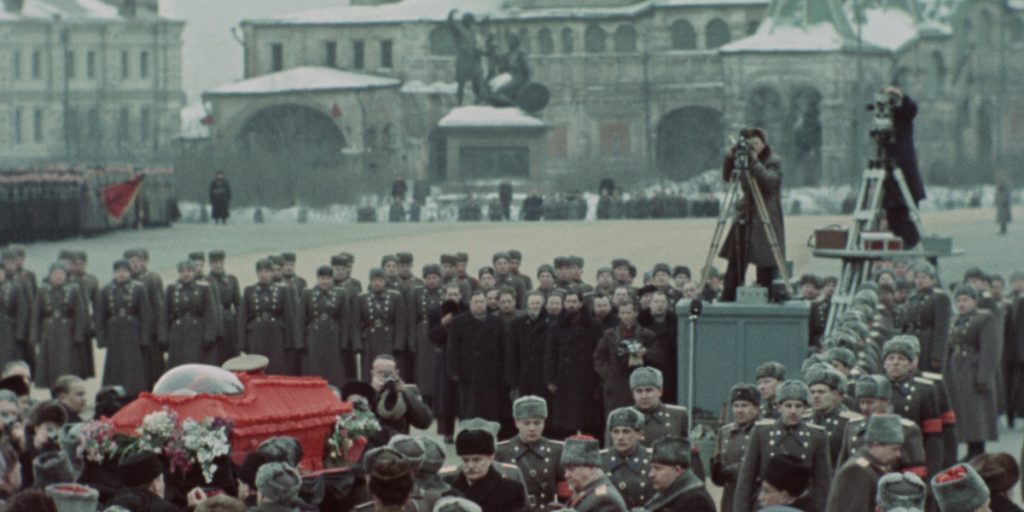Sergei Loznitsa’s remarkable yet gruelling documentary State Funeral uses archived propaganda footage to detail the death of Joseph Stalin and a nation’s muted response.
The death of Stalin. Not the Armando Iannucci film, but the event itself, on March 5th 1953, is the starting point for Sergei Loznitsa’s documentary State Funeral, which pieces together historical propaganda footage to form a visual timeline of the days immediately after his passing. It’s a remarkable piece of filmmaking that’s also a piece of genuine history, that tries the patience and questions the nature of nation-wide mourning.
State Funeral begins with the awkward placing of Stalin’s body ahead of his lying in state. Too many hands grapple with the coffin, and the process isn’t the smoothest, but soon his body is laid amidst a veritable sea of red flowers, wreathes and ribbons. The film then shows people gathered around loudspeakers, removing their caps and wiping away stray tears, as they hear the announcement that Joseph Vissarionovich Stalin has died. It’s shown happening across the breadth of the USSR, from an oil rig in Azerbaijan to the snowy village of Kharsaim in the far north, as it was a truly monumental moment for the Soviet Union. And over the course of the two hours runtime, everything from the gathering of mourners visiting his body to the preparations and the funeral procession itself is shown in exquisitely rendered detail.
The film offers a remarkable insight into the immediate aftermath of Stalin’s long reign, the end of his grip and power over millions of people. Hundreds gather round to hear the news, thousands queue through the streets for a glimpse of him lying in state and then gather in Moscow’s Red Square to see him laid to rest. Loznitsa presents the pomp and circumstance of Stalin’s funeral, from town after town, from angle after angle, in such a repetitive manner to demonstrate the idea of ‘personality cult’ and explore the mass commitment the Soviet people had to honouring a man who was not deserving of the romanticism his death announcement arrived with.
People carry wreathes twice their size in droves to lay at the base of Stalin’s memorial. Artists cluster around his body to paint, sculpt and draw him in death. Speeches are made about Stalin’s life’s purpose of liberation, of achieving ‘free and happy life on Earth for the working people’, and how his name is a ‘symbol of our triumph and joy’. But Loznitsa keeps returning the film’s focus to the ordinary people, to Stalin’s working force, and presents nothing but a sea of blank faces. Some look indifferent, some look bored, some look carefully neutral and a scant few cry as the procession continues. It’s disquieting and sombre, to see a nation in ‘mourning’ be so poised and controlled. It also seems to answer the question that might arise as to why this propaganda footage remained undiscovered for so long; it doesn’t exactly coincide with the rose-tinted image of a man who was entirely for the people. It looks more like a people who are there because it is expected of them, rather than to express genuine grief.
The film is an exhausting, relentless test of patience, but that’s precisely the point. It’s silent for long stretches, the speeches are delivered in full, and it feels like an exercise in endurance to make it to the end. State Funeral is a fascinating piece of hard work, a carefully pieced together look at the laying to rest of one of history’s most prolific dictators.
State Funeral is streaming exclusively on MUBI worldwide, and in select US & UK cinemas.

